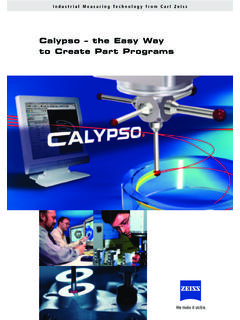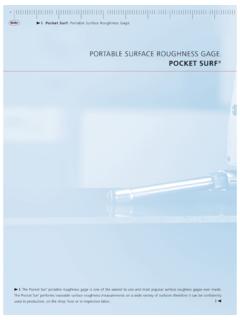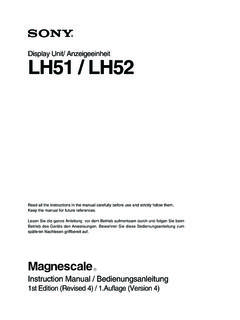Transcription of RDS. Articulating Probe Holder.
1 Industrial measuring Technology from Carl Probe MEASUREYou won't find a simpler or moreversatile technology. The Zeiss RDS makes it possible,for the first time ever, to reachvirtually all spatial angles with anextremely large number of discre-te is especially beneficial for measuring intrica-te parts that normally require probes configured formany spatial RDS knows no part is checked in its entirety using only oneprobe and one clamping set-up complicated Probe combinations means sim-ple parts measuring most cases, no Probe change is required. Thisincreases your throughput rate and reduces idle of applicationsNew: RDS-CAA with drastically reduced cali-bration time for Horizontal Arm now each Probe shaft from a Probe combinationhad to be calibrated manually. Each different spatial probingdirection needed for the measuring task had to be individu-ally RDS-CAA, for Horizontal Arm CMMs you only needto calibrate a few spatial directions the Probe in shaft align-ment with a CNC run, additional Probe shafts also with just afew manual probings.
2 Set-up time is greatly : Probe combination with 3 Probe shafts for 85 spatial pro-bing (approx.)calibrationRecalibrationRDS180 min. 5 deep sloped bores can be probed withoutshaftcontact. The RDS provides steps as small as !Ease of programming, the joysticks of the con-trol panel can be used to position the RDS. Thisgreatly simplifies operation, reducing programmingtimes and eliminating to full integration in the Zeiss software theRDS is able to be driven with the aid of joysticks inthe workpiece coordinate system. Conventional sy-stems only are able to be driven in the CMM coor-dinate inaccessible zones due tocomplete rotation about two axes of rotation are arranged laterallyand perpendicularly to each other; this ensures 180 of rotation in either axis. The lateral positionof the second axis results in optimum utilization ofthe CMM measuring range.
3 In addition, the widebearing base delivers high or automatic Probe Probe systems can be exchanged even with extensions. CNC-change permits auto-matic RDS owes its generally recognized Zeiss accuracy andreliability to a number of indexing steps of and high precision yield a vastnumber of wide base of the Hirth-type serration andthe great number of teeth guarantee utmost posi-tioning accuracy and minute step x 144 positions with 1 stability due to externalenergy control electronics are integrated in theCMM away from RDS. No separate housing unit isneeded. The serration is decoupled pneumaticallyand positioning is performed by low-energy probing double-trigger principle of the piezo-electricRST sensor makes the system independent of theprobing position and direction, and permits exten-sions of up to 300 mm (12 in.)
4 And probes of up to90 mm ( in.) in Renishaw TP6 and TP2 sensors are ma-nually or CNC changeable via a special Probe -changer adapter platewith high collision protection comes from the RSTsensor and disengagable adapter plate with dropprotection. Active contacting delivers automaticsensor .. in the standard initial setup or as a retrofittingoption in all Zeiss CMMs with an ST3 Probe 180 180 115 115 180 Inaccessible zoneThe RDS can reach 20,736 positions at indexing Articulating Probe holder only reach 720 positions(180 /115 with angular increments of ).Zeiss RDS/RSTC onventional indexing indexing stepsSpecificationsMounting on CMMR eproducible 3-point mount (ST3)Sensor receptionStandard: Manual change via push of a button at the control panel (electromagnetic reception)Option: CNC change in connection with Probe magazine and control softwareOverall dimensionsDiameter in mm (in.)
5 64 ( )Height in mm (in.) 140 ( )Weight(approx.)kg (lb)1 ( )Max. Articulating rangeRotary axis 180 Swivel axis 180 Positions (144 x 144)Maximum torque(Nm) extension for RSTin mm (in.) 300 (12)Positioning repeatability 1"Cycle time for 90 movement(s) < 3 Probe mounting repeatability 1"Air supplyVia air supply of CMMA mbient operating temperature+5 C to +40 C (41 F to 104 F)RSTG eneralRST direction-independent dynamic Probe head. Double-trigger principle by combining a mechanical switch and a piezoelectric dataRepeatability in m (in.) ( 020) at a Probe length up to 20 mm ( in.)Mounting position Freely selectableMinimum Probe tip dia. in mm (in.) ( )Permissible sound level75 dBA at sinusodial excitation80 dBA noiseWeights, dimensionsOverall dimensionsDiameter in mm (in.)26 (1)Length in mm (in.)56 ( )Weightin g (oz.)40 ( )ExtensionsDiameter in mm (in.)
6 26 (1)Max. length in mm (in.) 300 (12)RenishawTP6, TP2 Mounted on a special Probe -changer adapter plate;CNC-changeable from/to a environmental ConditionsSupply DataPerformance DataDimensions, WeightsGeneralRDS60-20-109/I-ePrinted in Germany. III/2000 NooSubject to technical modification and to changes in scope and design. Printed on chlorine-free paper. Carl Zeiss conception, text and design: Carl ZeissUnternehmensbereichIndustrielle Me technikD-73446 OberkochenSales: +49 18 03/33 63 36 Service: +49 18 03/33 63 37 Fax: +49 73 64/20-38 70E-mail: measuring Technology from Carl ZeissVAST XXT the Zeiss scanning solution for RDSWe make it scanningability on RDSR eliable and easy integrationAffordable and accurateVAST with an Articulating probeholderOur active scanning VAST sensorshave become firmly established inmetrology for applications requiringmaximum accuracy with large stylusconfigurations.
7 Next to these appli-cations, however, there are a largenumber of areas where users wel-come the flexibility offered by an ar-ticulating Probe holder , if workpiecetolerances permit. The VAST XXT passive sensor enables scanning with anRDS Articulating Probe holder with high accuracy andsmall dimensions. It supplements the VAST sensor linefor applications in which the flexibility of an articulatingprobe holder is a replacement for trigger sensors, VAST XXT offersbetter measurement reliability and accuracy. It alsoadds scanning functionality to the measurement spec-trum, thus providing more information on the shape 20,376 positions that the RDS Articulating Probe holder allows in increments, guarantee optimal accessibility of the rangeConventional Articulating Probe holderRDSS canningVAST XXTS ingle pointsTP6 RST-PSingle pointPassive scanningOpticalArticulatingOpticalTP20 ViScanDTSRDS35 swivel range35 angleConventional Articulating Probe holder130 unusable area30 swivel range35 angleOptional on RDSYour one-stop providerThe development and integration of all relevant components atCarl Zeiss ensure maximum performance for the entire from Carl ZeissSoftware from Carl ZeissCalibration algorithms from Carl ZeissOptimal integrationOutstanding scanning softwareThe MCC 800 controller allows the use of VAST XXT on newcoordinate measuring machines.
8 As well as those that couldpreviously only use touch-trigger probes . A synchronizationprocedure (patent pending) reliably allocates the machine co-ordinates without interruption. This significantly increases thestability of the system compared to standard analog 2 thermally stable stylus modules- Fewer components- Reduced influence of errors- Less calibration- Fewer stylus changes- More productive measurement proceduresStylus lengths up to 250 mm25 mm diameter adapter plate for maximum reproducibilityLarge deflection range: +/- 3 mm for highest possible collision protectionScanning sensor with automatic recognition of new stylus moduleMinimum influence of deflection in Articulating modeDigital signal transmission for maximum operational reliabilityLateral stylus can be usedAutomatic stylus changeSensor change on RDS (ViScan, )Minimum measuring forces for a wide spectrum of work piecesStylus rack (top) andmeasurement with lateralstylus on VAST XXT(bottom)For advice, please contact.
9 60-20-127-ePrinted in Germany W-TS-VI/2004 NooSubject to change. Printed on chlorine-free paper. Carl ZeissIndustrielle Messtechnik GmbH73446 OberkochenGermanyTel.: ++49 (01803) 336 336 Email.








